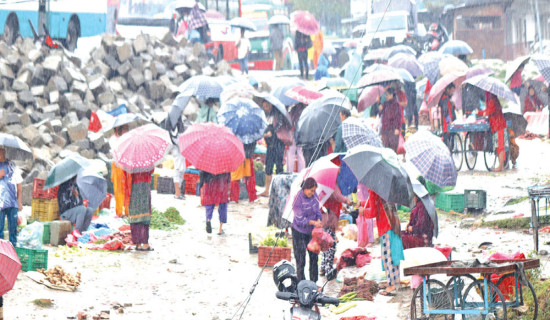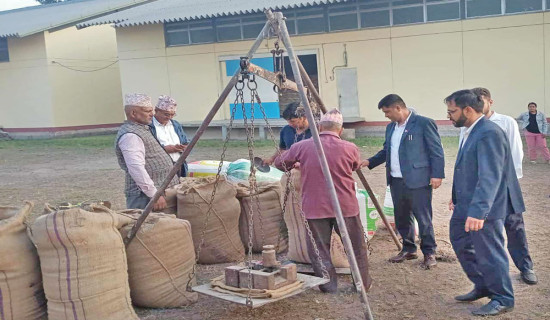- Sunday, 30 November 2025
Indicators of external sector of economy strengthen further
Kathmandu, Mar. 11: The indicators of the external sector of the economy have improved further, according to the latest current macroeconomic and financial situation report of the Nepal Rastra Bank (NRB).
Foreign currency reserves, balance of payment, current account and remittance inflows have grown increasingly positive in the first seven months of the current fiscal year 2023/24.
The current macroeconomic and financial situation report of the first seven months of the current fiscal year made public by the NRB on Sunday, has shown that significant increase in the remittance inflows has led to an increase in foreign exchange reserves and other indicators have also strengthened.
Economist Dr. Chandra Mani Adhikari said that remittances sent by the workers who went abroad for employment have contributed significantly to increase the foreign currency reserves and to make balance of payments and current account positive.
At a time when the country’s productivity has not increased to the desired level, a significant increment in remittance inflows gives lifeline to the national economy along with improving indicators of the external sector of the economy, he said.
Stating that the increase in remittance inflows will help the national economy in the short term, he said that instead of being happy with the current increase in remittance flows, the government should pay attention to increasing productivity and augmenting exports as a source of foreign exchange earnings.
Remittance worth Rs. 839 billion received
According to the report, remittance inflows increased by 21.6 per cent to Rs. 839 billion in the review period compared to an increase of 27.1 per cent in the same period of the previous year.
In the US dollar terms, remittance inflows increased by 19.1 per cent to 6.31 billion in the review period compared to an increase of 16.4 per cent in the same period of the previous year.
The report showed that remittance of Rs. 106 billion has been received in a single month from mid-January to mid-February 2024 of the current fiscal year.
The country had received remittance of Rs. 120 billion from mid-December 2023 to mid-January 2024.
In the review period, the number of Nepali workers, both institutional and individual, taking first time approval for foreign employment stood at 247,012 and taking approval for renewed entry stood at 158,540. In the previous year, such numbers were 314,767 and 167,708 respectively.
Net transfer increased 20.0 per cent to Rs. 910.74 billion in the review period. Such a transfer had increased by 25.2 per cent in the same period of the previous year.
Foreign currency reserves set record of Rs. 1,845 billion
According to the report, the foreign currency reserves reached an all-time high of Rs. 1,844.94 billion during the first seven months of the current fiscal year.
Foreign currency reserves increased by about Rs. 28.37 billion during a single month (mid-January to mid-February 2024). The foreign currency reserves amounted to Rs. 1,816.57 billion in mid-January 2023.
“Growth of remittance inflows is the major factor to set record in foreign currency reserves in the country. Four major sectors—export, foreign direct investment, foreign aid and tourism—are the main sources of foreign currency earnings. But, the export has remained low while the FDI has slightly improved. In this context, remittance played a significant role to make the position of foreign currency reserves strong,” he told The Rising Nepal.
He said that the government should focus on increasing exports and attracting more FDI and create an environment to bring tourists for sustainable source of foreign currency earning of the nation.
The share of Indian currency in total reserves stood at 22.6 per cent in mid-February 2024.
Based on the imports of seven months of 2023/24, the foreign exchange reserves of the banking sector is sufficient to cover the prospective merchandise imports of 14.7 months, and merchandise and services imports of 12.3 months.
BOP surplus almost Rs. 300 billion
Meanwhile, there has been further improvement in the current account and Balance of Payments (BOP) during the review period.
The Balance of Payments (BOP) remained at a surplus of Rs. 297.72 billion in the review period against a surplus of Rs. 128.55 billion in the same period of the previous year.
In the US dollar terms, the BOP remained at a surplus of 2.24 billion in the review period against a surplus of 975.7 million in the same period of the previous year.
Similarly, the current account remained at a surplus of Rs. 161.69 billion in the review period against a deficit of Rs. 40.16 billion in the same period of the previous year.In US dollar terms, the current account registered a surplus of 1.22 billion in the review period against a deficit of 314.6 million in the same period last year.
In the review period, capital transfer decreased by 29 per cent to Rs. 3.80 billion and net foreign direct investment (FDI) remained positive at Rs. 5.18 billion.
In the same period of the previous year, capital transfer amounted to Rs. 5.35 billion and net FDI amounted to Rs. 1.04 billion.
Inflation drops to 5%
Meanwhile, consumer price inflation has decreased during the first seven months of the current fiscal year as compared to the same period last fiscal year.
The y-o-y consumer price inflation moderated to 5.01 per cent in mid-February 2024 compared to 7.88 per cent a year ago.
Food and beverage category inflation stood at 6.51 per cent whereas non-food and service category inflation stood at 3.85 per cent in the review months.
Under the Food and Beverage Category, y-o-y price index of spices sub-category increased by 32.11 per cent, pulses and legumes by 11.15 per cent, milk products and eggs by 10.78 per cent, cereal grains and their products by 9.06 per cent and vegetables by 7.58 per cent in the review month.
The y-o-y price index of ghee and oil sub-category decreased by 12.33 per cent in the review month.
Under the Non-Food and Services Category, the y-o-y price index of the recreation and culture sub-category increased by 12.61 per cent, miscellaneous goods and services by 9.15 per cent and education by 7.31 per cent in the review month.
The y-o-y price index of transportation sub-category decreased by 1.41 per cent in the review months.
The y-o-y wholesale price inflation stood at 2.82 per cent in mid-February 2024 compared to 9.67 per cent a year ago.
Similarly, the y-o-y wholesale price index of consumer goods, intermediate goods and capital goods increased by 7.05 per cent, 0.72 per cent and 1.79 per cent respectively.
The y-o-y wholesale price index of construction materials decreased by 5.32 per cent in the review months.
The y-o-y salary and wage rate index increased by 5.56 per cent in mid-February 2024 compared to 10.27 per cent a year ago.
The y-o-y salary index and wage rate index increased by 1.05 and 6.92 per cent respectively in the review months of the current fiscal year.






-original-thumb.jpg)




-original-thumb.jpg)





